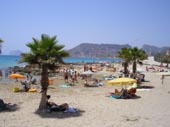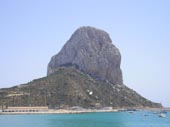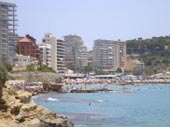Calpe Spain
Information on the popular coastal resort of Calpe Spain.



Coastal Resorts of Spain - Calpe Costa Blanca
Calpe Spain - Located some 67 km north of Alicante on the Costa Blanca, Spain is the splendid seaside resort of Calpe (Calp), overlooked by one of the best loved landmarks of the Costa Blanca region - the Peñon de Ifach, Calpe is a very busy holiday resort, with a local population of around 26,000 (this of course rises considerably during the busy the summer months of July and August). Calpe is situated within the Communidad de Valencia, Spain.
Boasting some super beaches and a great selection of bars and restaurants, Calpe is a superb location for a holiday, but is also a great spot for the day tripper, who will find some fine places to visit.
Calpe Spain has a long and fascinating history and has been occupied over the centuries by Iberians, Phoenicians, Romans and Moors. The Romans incorporated a fish salting factory in Calpe in the area of Los Baños de Reina, close to the current promenade, and the Arabs built the ancient Castle of Calpe, from which they defended Calpe until defeated in about 1240 by the Christian forces of the Conquistador King Jaime I.
A miniscule town known as ‘Ifach’ was fabricated on the slopes of the Peñon de Ifach in around 1290 by an Aragon Admiral (Roger de Lauria), and later the walls were strenghtened and fortified by King Pedro II, to defend the town from attacks by morisco (Barbary) pirates who sailed these coasts for many centuries. The tiny town of Ifach was eventually destroyed in the War of the Two Pedros (1359), and the former inhabitants fled to a nearby farmhouse, which overlooked the Bay of Calpe, it was in the area around this farmhouse that present day Calpe grew and developed. This newly emerging town also constructed a fortified wall to fend off pirate attacks, though it continued to suffer frequent incursions.
In 1659 Calpe Spain suffered seriously when the town was sacked and looted, and almost three hundred of its inhabitants were taken to North Africa (Algiers), where they were incarcerated for five years or so, until exchanged for some gold and the release of a number of pirate prisoners.
From around this time forwards, Calpe Spain began to grow significantly and houses began to appear outside of the town walls as the threat of pirate attacks faded. The primary industry at that time was fishing, but almost as significant was salt production, Calpe having its own salt flats, which lie behind the present day town..
During the 1930’s the beginnings of a tourist industry began to develop in Calpe and some sea-front hotels were built to cater for the new Spanish middle-classes. This industry flourished throughout the 1940’s and 1950’s and boomed in the 1960’s as it did in much of Spain, when cheaper and more available transport, brought visitors to Calpe from all over Europe and in fact the world. Nearby Benidorm underwent similar if more spectacular growth. The sunny weather conditions no doubt contributing to this increased popularity.
Calpe has continued to expand, together with the whole of the Costa Blanca region, and today has a number of high-rise apartment blocks and hotels, mainly at the northern end of the town. Aside from the spectacular Peñon de Ifach, the majority of the interesting places to visit are situated in the old town and these include the Torreó de la Peca, the Iglesia Antigua (‘Old Church’, originally from the Fifteenth Century), Placa dels Mariners, and the Ermita de San Salvador (originally from the 18th Century but later re-built). There are lots of other interesting places to visit in and around Calpe, both old and new, and many of these are outlined in a useful guide that can be picked up at the local Tourist Information Centre. Calpe Spain enjoys a wonderful mild climate and all year round Calpe weather is predominantly sunny and warm.
The extraordinary Peñon de Ifach is made up of 50,000 m2 of calcareous rock, which erupts vertically from the sea, to a height of over three hundred metres, dominating the sky-line of Calpe. The rock is now a protected Natural Park, although visitors are allowed to climb to the summit by way of a tunnel, which was carved into solid rock early in the 20th Century, to make the journey easier. The numbers of visitors allowed onto the rock are limited and you should try to arrive early in order to obtain your free entrance ticket.
Calpe Spain can be easily accessed from the N332 coastal road and the AP-7 motorway, you can find a decent map here (MAP), to help you find your way to the resort.
Calpe Links: Calpe Guide - Calpe Map - Calpe Weather - Calpe Properties - Calpe Beaches - Calpe Spain - Calpe History - Calpe Alicante - Calpe Costa Blanca
Nearby Places: Benidorm - Denia - Moraira - Altea - Albir - Javea - Guadalest - Callosa d'en Sarria - Finestrat - Benissa - Cumbre del Sol - Alfaz del Pi
Attractions: Terra Mitica - Aqualandia - Mundomar - Terra Natura - Penon de Ifach - Caves of Canelobre - Fuentes de Algar - Penyal D'Ifac
Golf Courses: Ifach Golf Club - Real Faula Golf - Spain Golf
Related: Alicante - Valencia - Alicante Weather - Alicante Transfers - Spain - Builders
HOME
